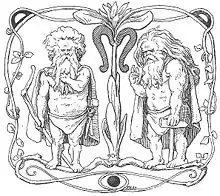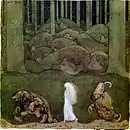Dwarf (folklore)
In Germanic folklore, including Germanic mythology, a dwarf is an entity that dwells in mountains and in the earth. The entity is variously associated with wisdom, smithing, mining, and crafting. Dwarfs are sometimes described as short and ugly, although some scholars have questioned whether this is a later development stemming from comical portrayals of the beings.[1] Dwarfs continue to be depicted in modern popular culture in a variety of media.

Etymology
The modern English noun dwarf descends from the Old English dweorg, specifically the nominative and accusative form dweorh. It has a variety of cognates in other Germanic languages, including Old Norse dvergr and Old High German twerg. According to Vladimir Orel, the English noun and its cognates ultimately descend from Proto-Germanic *đwergaz.[2]
A different etymology of dwarf traces it to Proto-Germanic *dwezgaz, with r being the product of Verner's Law. Anatoly Liberman connects the Germanic word with Modern English dizzy: allegedly, dwarfs inflicted mental diseases on humans, and in this respect did not differ from elves and several other supernatural beings.[3]
For forms earlier than the Proto-Germanic reconstruction, the etymology of the word dwarf is highly contested. Scholars have proposed theories about the origins of the being by way of historical linguistics and comparative mythology, including that dwarfs may have originated as nature spirits, as beings associated with death, or as a mixture of concepts. Competing etymologies include a basis in the Indo-European root *dheur- (meaning 'damage'), the Indo-European root *dhreugh (whence, for example, modern English dream and German Trug 'deception'), and comparisons have been made with Sanskrit dhvaras (a type of "demonic being").[1]
Plural forms
Modern English has two plurals for the word dwarf: dwarfs and dwarves. Dwarfs remains the most commonly employed plural.
The minority plural dwarves was recorded as early as 1818. However, it was later popularized by the fiction of philologist and legendarium author J. R. R. Tolkien, originating as a hypercorrective mistake. It was employed by Tolkien since some time before 1917.[4]
Regarding his use of this plural, Tolkien wrote in 1937, "I am afraid it is just a piece of private bad grammar, rather shocking in a philologist; but I shall have to go with it".[4]
Norse mythology and later folklore
Norse mythology provides different origins for the beings, as recorded in the Poetic Edda (compiled in the 13th century from earlier traditional sources) and the Prose Edda (written by Snorri Sturluson in the 13th century). The Poetic Edda poem Völuspá details that the dwarfs were the product of the primordial blood of the being Brimir and the bones of Bláinn (generally considered to be different names for the primordial being Ymir). The Prose Edda, however, describes dwarfs as beings similar to maggots that festered in the flesh of Ymir before being gifted with reason by the gods. The Poetic Edda and Prose Edda contain over 100 dwarf names, while the Prose Edda gives the four dwarfs Norðri, Suðri, Austri and Vestri (Old Norse 'North, South, East, and West') a cosmological role: they hold up the sky.[1] In addition, scholars have noted that the Svartálfar (Old Norse 'black elves') appear to be the same beings as dwarfs, given that both are described in the Prose Edda as the denizens of Svartálfaheimr.[5]
Very few beings explicitly identifiable as dwarfs appear in the Poetic Edda and Prose Edda, and they have quite diverse roles: murderous creators who create the mead of poetry, 'reluctant donors' of important artifacts with magical qualities, or sexual predators who lust after goddesses.[6] They are primarily associated with metalsmithing, and also with death, as in the story of King Sveigðir in Ynglinga saga, the first segment of the Heimskringla—the doorways in the mountains that they guard may be regarded as doors between worlds.[7] One dwarf named Alvíss claimed the hand of Thor's daughter Þrúðr in marriage, but he was kept talking until daybreak and turned to stone, much like some accounts of trolls.[8]
After the Christianization of the Germanic peoples, tales of dwarfs continued to be told in the folklore of areas of Europe where Germanic languages were (and are) spoken.[9] In the late legendary sagas, dwarfs demonstrate skill in healing as well as in smithing.[10] In the early Norse sources, there is no mention of their being short; in the legendary sagas, however, they are "small and usually ugly".[1] Anatoly Liberman suggests that dwarfs may have originally been thought of as lesser supernatural beings, which became literal smallness after Christianization.[11] Old Norse dwarf names include Fullangr ('tall enough') and Hár ('high'), whereas Anglo-Saxon glosses use dweorg to render Latin terms such as nanus and pygmaeus ('pygmy').[12][13]
Dwarfs in folklore are usually described as old men with long beards.[13] Female dwarfs are hardly ever mentioned. Dvalinn the dwarf has daughters, and the 14th-century romantic saga Þjalar Jóns saga gives the feminine form of Old Norse dyrgja, but the few folklore examples cited by Grimm in Teutonic Mythology may be identified as other beings.[14][15] However, in the Swedish ballad "Herr Peder och Dvärgens Dotter" (Swedish 'Sir Peder and the Dwarf's Daughter'), the role of supernatural temptress is played by a dwarf's daughter.[16]
Anglo-Saxon medicine
The Anglo-Saxon charm Wið Dweorh (Against a Dwarf) appears to relate to sleep disturbances. This may indicate that the dwarf antagonist is similar to the oppressive supernatural figure the mare which is the etymological source of the word "nightmare" or possibly that the word had come to be used to mean "fever".[12][17] In the Old English Herbal, it translates Latin verrucas, warts.[12]
Middle High German heroic poetry
In Middle High German heroic poetry, most dwarfs are portrayed as having long beards, but some may have a childish appearance.[18] In some stories, the dwarf takes on the attributes of a knight.[19] He is most clearly separated from normal humans by his small size, in some cases only reaching up to the knees.[20] Despite their small size, dwarfs typically have superhuman strength, either by nature or through magical means.[21] Many dwarfs have the ability to make themselves invisible, typically via a "Tarnkappe" (cloak of invisibility), which seems to be a very old attribute of the dwarfs. They also possess other magical objects, and often appear as master smiths.[22] Typically they live inside of hollow mountains, though in some cases they may live above the ground.[23] Depending on the story, they may be hostile or friendly to humans.[24] Male dwarfs are often portrayed as lusting after human women, whereas female dwarfs seek to possess the male hero in the legends.[25]
The dwarf Alberich plays an important role in the Nibelungenlied, where he guards the Nibelung's treasure and has the strength of twelve men. He is defeated by Siegfried and afterwards serves the hero. In Ortnit, Alberich seduces the queen of Lombardy, thereby begetting the hero Ortnit. The dwarf then aids Ortnit in his adventures after revealing to the hero that he is his father. In Das Lied vom Hürnen Seyfrid, Siegfried is aided by the dwarf Eugel, who is son of the dwarf king Nibelung, originator of the Nibelung's treasure.
The hero Dietrich von Bern is portrayed in several adventures involving dwarfs. In Laurin, he fights against the dwarf King Laurin at the dwarf's magical rose garden and later rescues a woman whom Laurin had kidnapped. A similar plot occurs in the fragmentary poem Goldemar. In Virginal, Dietrich rescues the dwarf queen Virginal from a force of invading heathens. The dwarfs Eggerich and Baldung play a role in aiding Dietrich in the poem Sigenot: Baldung gives Dietrich a magical gem that prevents him from being bitten when thrown into a snake pit, whereas Eggerich helps Dietrich and Hildebrand escape. In the Heldenbuch-Prosa, a dwarf takes Dietrich out of this world after the death of all the other heroes, a role given to Laurin in some other versions of Dietrich's end.
Scholarly interpretations
John Lindow noted that stanza 10 of the Poetic Edda poem Völuspá can be read as describing the creation of human forms from the earth and follows a catalog of dwarf names; he suggests that the poem may present Ask and Embla as having been created by dwarfs, with the three gods then giving them life.[26]
Modern influence
.jpg.webp)
There were seven dwarfs in the Brothers Grimm's fairy tale Snow White. Walt Disney's 1937 film based on the story, is one of the most well-known adaptation today.
Most dwarfs in modern fiction closely follow those of J. R. R. Tolkien's The Lord of the Rings, where the dwarves (Tolkien's spelling) were distinguished from elves. Most modern fantasy media have continued this distinction, beginning with TSR's Dungeons & Dragons. Dungeons & Dragons calls the dwarfs "dwarves" and the dark dwarves "duergar". They are also present in C. S. Lewis's The Chronicles of Narnia, in both the books and the film adaptations.
Notes
- Simek (2007:67–68).
- Orel (2003:81).
- Liberman (2016:312–314).
- Gillver, Marshall, & Weiner (2009:104-108).
- Simek (2007:305), Orchard (1997:35), and Hafstein (2002:111).
- Jakobsson (2005).
- Motz (1983:90–91, 105–06); Gundarsson (2007:81, 83).
- Gundarsson (2007:74).
- Lindow (2001:101).
- Gundarsson (2007:87).
- Liberman (2008:57).
- Griffiths (1996:54).
- Gundarsson (2007:73).
- Gundarsson (2007:77–78).
- Liberman (2008:58).
- Gundarsson (2007:78).
- Storms (1948:168).
- Lütjens 1911, pp. 70-72.
- Lütjens 1911, pp. 69-70.
- Lütjens 1911, p. 74.
- Lütjens 1911, pp. 79=80.
- Lütjens 1911, pp. 80-86.
- Lütjens 1911, pp. 91-92.
- Lütjens 1911, pp. 94-98.
- Lütjens 1911, p. 103.
- Lindow (2001:62–63).
References
- Gilliver, Peter. Mashall, Jeremy. Weiner, Edmund (2009). The Ring of Words: Tolkien and the Oxford English Dictionary. Oxford University Press. ISBN 9780199568369.
- Gundarsson, KveldulfR Hagan (2007). Elves, Wights, and Trolls. Studies Towards the Practice of Germanic Heathenry, 1. iUniverse. ISBN 978-0-595-42165-7
- Gygax, Gary (1979). "Books Are Books, Games Are Games". Dragon, 31. Repr. (1981) in: Kim Mohan, ed. Best of Dragon, Volume 2: A collection of creatures and characters, opinions and options from the first four years of Dragon magazine. Dragon, ISBN 9780935696943
- Griffiths, Bill (1996). Aspects of Anglo-Saxon Magic. Anglo-Saxon Books. 1-898281-15-7
- Hafstein, Valdimir Tr. (2002). "Dwarfs" as collected in Lindahl, Carl. McNamara, John. Lindow, John. (2002). Medieval Folklore. Oxford University Press. ISBN 978-0-19-514772-8
- Jakobsson, Ármann (2005): "The Hole: Problems in Medieval Dwarfology," Arv 61 (2005), 53–76.
- Liberman, Anatoly (2008). An Analytic Dictionary of English Etymology. University of Minnesota Press. ISBN 9780816652723
- Liberman, Anatoly (2016). In Prayer and Laughter. Essays on Medieval Scandinavian and Germanic Mythology, Literature, and Culture. Paleograph Press. ISBN 9785895260272
- Lütjens, August (1911). Der Zwerg in der deutschen Heldendichtung des Mittelalters. Breslau: M. & H. Marcus.CS1 maint: ref=harv (link)
- Lindow, John (2001). Norse Mythology: A Guide to the Gods, Heroes, Rituals, and Beliefs. Oxford University Press. ISBN 0-19-515382-0
- Motz, Lotte (1983). The Wise One of the Mountain: Form, Function and Significance of the Subterranean Smith: A Study in Folklore. Göppinger Arbeiten zur Germanistik, 379. Kümmerle. ISBN 3-87452-598-8
- Orchard, Andy (1997). Dictionary of Norse Myth and Legend. Cassell. ISBN 0-304-34520-2
- Orel, Vladimir (2003). A Handbook of Germanic Etymology. Brill. ISBN 9004128751
- Schäfke, Werner (2015): Dwarves, Trolls, Ogres, and Giants. In Albrecht Classen (Ed.): Handbook of medieval culture. Fundamental aspects and conditions of the European Middle Ages, vol. 1. Berlin: de Gruyter, pp. 347–383.
- Simek, Rudolf (2007) translated by Angela Hall. Dictionary of Northern Mythology. D.S. Brewer ISBN 0-85991-513-1
- Storms, Godfrid (1948). Anglo-Saxon Magic. Nijhoff. OCLC 462857755
| Wikimedia Commons has media related to Dwarves (legendary creatures). |
